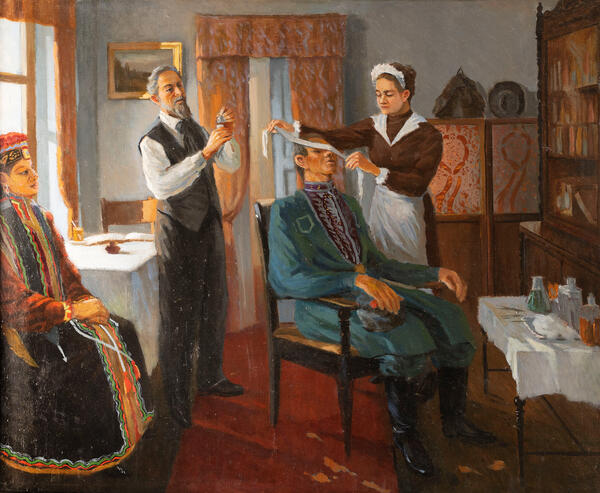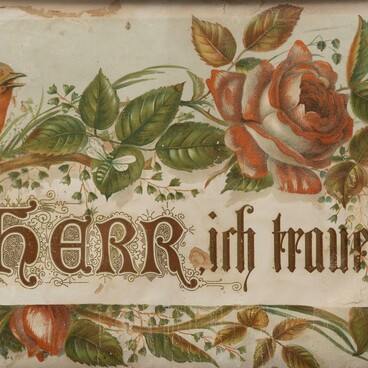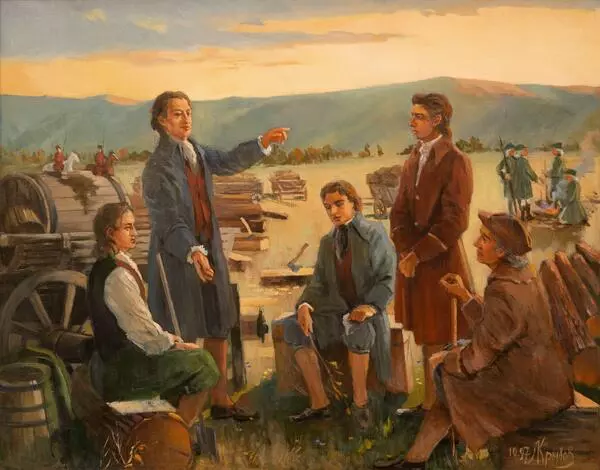The first doctor in the German colony of Sarepta was Dr. Johann Veer who studied medical science in Berlin. He arrived in Sarepta in 1766 and immediately earned the trust not only among residents from neighboring villages, but also among Kalmyks.
Respect for Veer as a doctor among Kalmyks strengthened after he successfully cured the Kalmyk prince Tohmut from a dangerous tumor on his arm and from suppuration of the hand. Until his complete recovery, the prince lived with his retinue next to Sarepta and gave Sarepta advices on how to improve relations with the Kalmyks. These advices helped the colonists to get closer to the Kalmyks and start making their missionary journeys to the Kalmyk hordes.
Healing the nomads was not easy for prejudice and superstition interfered. According to the testimony of the Sarepta doctor, one of the Kalmyks could not make up his mind to bleed from his right hand, since according to the statement of Gelyung, a Kalmyk priest, his soul that day was in this hand. He could allow this procedure only when his soul ‘is in his big toe.’
After Veer’s death, Dr. Karl Seidel became the community doctor and famous for his complex surgical operations. A pharmacy appeared in Sarepta already in 1766. It was not inferior not only to the district, but also to the provincial pharmacies. Here medicines were dispensed strictly according to a prescription with a seal and a doctor’s signature. The buyer was provided with instructions for the medicine use.
In 1831, Franz Langerfeld started working in a pharmacy. He invented the famous Sarepta balsam and organized a balsam production in Sarepta. The balsam was a strong alcoholic drink of greenish color with a pleasant smell, infused with wine alcohol with local herbs, and was used for medicinal purposes. Sarepta Balsam was even awarded the Gold Medal at the World Exhibition in Paris in 1867.
There was no community hospital in Sarepta until the middle of the 19th century. Treatment was carried out at the doctor’s home, as shown in Krylov’s picture. Or the doctor went to the patient himself. Only in 1856 a hospital building was built to treat both community members and other patients.
A private hospital was constructed in the colony in 1864 to treat throat and lungs with kumis and chigan - sour mare’s milk. Since 1888 there was a county hospital with an outpatient clinic in Sarepta.
Medical education and services for the colonists, sanitary measures taken in the colony led to the fact that during the entire existence of the colony neither the plague epidemic nor the cholera epidemic affected Sarepta and did not take a single colonist’s life.
Respect for Veer as a doctor among Kalmyks strengthened after he successfully cured the Kalmyk prince Tohmut from a dangerous tumor on his arm and from suppuration of the hand. Until his complete recovery, the prince lived with his retinue next to Sarepta and gave Sarepta advices on how to improve relations with the Kalmyks. These advices helped the colonists to get closer to the Kalmyks and start making their missionary journeys to the Kalmyk hordes.
Healing the nomads was not easy for prejudice and superstition interfered. According to the testimony of the Sarepta doctor, one of the Kalmyks could not make up his mind to bleed from his right hand, since according to the statement of Gelyung, a Kalmyk priest, his soul that day was in this hand. He could allow this procedure only when his soul ‘is in his big toe.’
After Veer’s death, Dr. Karl Seidel became the community doctor and famous for his complex surgical operations. A pharmacy appeared in Sarepta already in 1766. It was not inferior not only to the district, but also to the provincial pharmacies. Here medicines were dispensed strictly according to a prescription with a seal and a doctor’s signature. The buyer was provided with instructions for the medicine use.
In 1831, Franz Langerfeld started working in a pharmacy. He invented the famous Sarepta balsam and organized a balsam production in Sarepta. The balsam was a strong alcoholic drink of greenish color with a pleasant smell, infused with wine alcohol with local herbs, and was used for medicinal purposes. Sarepta Balsam was even awarded the Gold Medal at the World Exhibition in Paris in 1867.
There was no community hospital in Sarepta until the middle of the 19th century. Treatment was carried out at the doctor’s home, as shown in Krylov’s picture. Or the doctor went to the patient himself. Only in 1856 a hospital building was built to treat both community members and other patients.
A private hospital was constructed in the colony in 1864 to treat throat and lungs with kumis and chigan - sour mare’s milk. Since 1888 there was a county hospital with an outpatient clinic in Sarepta.
Medical education and services for the colonists, sanitary measures taken in the colony led to the fact that during the entire existence of the colony neither the plague epidemic nor the cholera epidemic affected Sarepta and did not take a single colonist’s life.







